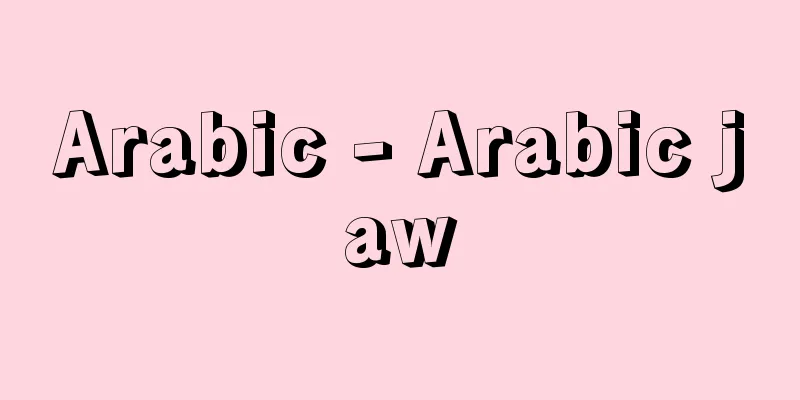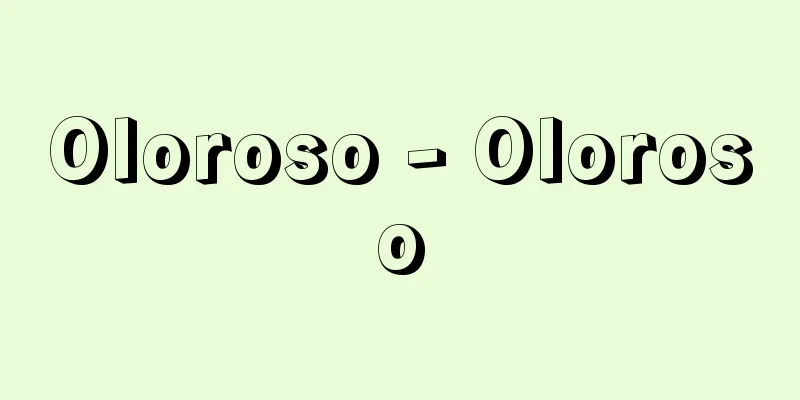Arabic - Arabic jaw

|
A large group of languages belonging to the southwestern branch of the Semitic (Afro-Asiatic) languages. It has an extremely large number of documents dating back to about 15 centuries from the 4th century, and today it is said to have tens of millions of users. Arabic was originally a local language in the Arabian Peninsula, but with the rise of Islam it was respected as a term in the holy book, the Quran, and developed into a language that supports Islam. In the process, its usage diversified and the number of people using it increased, and today it is the primary language of Muslims around the world. Arabic is broadly divided into formal Arabic (Fusha) and folk Arabic (Anmiya). "Formal Arabic" is a somewhat artificial language that was developed with the development of Islam, based on the Arabic of the Quran, and most classical Arabic literature is written in it. It has an extremely complex grammar system and is capable of expressing advanced ideas and scientific knowledge from Islamic and foreign studies. In modern times, it is used as a term in newspapers, magazines, and general books, as well as in radio and television news and lectures. Originally a literary language, it has come to incorporate colloquial elements, and is now also called "standard Arabic." "Folk Arabic" is used as an everyday language in various parts of the Arab world and is considered a dialect group with a wide range of use. It is broadly divided into Iraqi dialect, Syrian dialect, Egyptian dialect, and North African dialect, and these are further subdivided, but many other dialect groups are recognized. Civil Arabic differs from regular Arabic in pronunciation, vocabulary, phrasing, some grammar, and there are considerable differences between the dialects. Today, due to increasing contact between Arabs living in distant places, a common Civil Arabic is emerging. [Yajima Fumio] characterThe earliest known Arabic documents are the Namara inscription, dated 328, the Zabad inscription, dated 512/513, and the Harran inscription, dated 568, written in the Aramaic Nabataean script, strongly influenced by Aramaic. However, few pre-Islamic Arabic inscriptions are known. The Arabic script known as Kufic came into use in the Kufa region of southern Iraq at the end of the 1st century of the Islamic calendar (7th century AD), and in the following century, the method of making paper was introduced from the East and the script used for writing today was created. The most common script was Naskhī, the Ruqā script was often used in everyday life, and many other scripts emerged. These are the basis for the Arabic typeface of today. Like other Semitic scripts, Arabic mainly records consonants, with vowels and other symbols added only when necessary. Furthermore, it is mainly regular Arabic that is written in Arabic script; folk Arabic is not usually written in Arabic, although it has recently begun to be used in conversational Arabic in newspapers and magazines. [Yajima Fumio] grammarRegular Arabic has 28 consonants and 8 vowels (u, a, i, u- , a- , i- , au, ai). In folk Arabic, some consonants have regional variations, and the vowels are often more complex. The characteristic of Arabic words is that three or four roots (groups of consonants) determine the basic meaning, and vowels and additional elements indicate the details of the word's meaning. For example, d-r-s means "to learn," darastu means "I learned," yadrus means "he learns," dars means "to learn" or "class," and madrasa means "place to learn" or "school." Because verbs have 13 personal conjugations and various derivational forms, theoretically more than 1,000 word forms can arise from a single root. These derived words are sometimes used as new words, and it is said that this richness of word-making ability made regular Arabic a major literary language in the Middle Ages, on a par with Latin. The original word order of regular Arabic is "predicate + subject + complement" (for example, "He studied his studies" is darasa huwa darsa-hu, "study-he-study-his"). However, in modern standard Arabic, the influence of modern European languages has increased both in vocabulary and grammar, and this word order is no longer strictly adhered to. With the rise of Islamic learning from the second half of the 8th century onwards, scholars and writers produced a great number of canonical Arabic texts, one of which was grammar and the creation of dictionaries. Well-known works include Khalil's Book of Ayn, Shebawayhi's Kitab, and Ibn Manzur's The Language of the Arabs. In Europe, Arabic studies emerged in medieval Spain and early modern Holland, and became mainstream in England, France and Germany, where they continue to this day. [Yajima Fumio] [Reference] |Source: Shogakukan Encyclopedia Nipponica About Encyclopedia Nipponica Information | Legend |
|
セム語族(アフロ・アジア語族)南西分派に属する一大語群。4世紀以降約15世紀間にわたるきわめて多数の文献をもち、また今日では一億数千万人の使用者が数えられる。アラビア語は当初アラビア半島における地方語であったが、イスラム教の興隆とともに聖典コーランの用語として尊重され、イスラム教を支える言語として発展した。その過程で用法が多様化し、使用人口が増大し、今日では全世界にわたるイスラム教徒の主要用語となっている。 アラビア語は正則アラビア語(フスハー)と民間アラビア語(アンミーヤ)に大別される。「正則アラビア語」はコーランのアラビア語を規範としつつ、イスラム教の発展とともにつくりあげられた多少とも人工的な言語で、古典アラビア語文学の大半はこれで書かれている。きわめて複雑な文法体系をもち、イスラム諸学および外来諸学の高度の思想や科学的知識を表現することができた。また近代になると、新聞、雑誌、一般書籍の用語として用いられるとともに、ラジオ、テレビにおけるニュース、講演などにも用いられている。本来は文語であったが、口語的要素が取り入れられるようになっているため、今日では「標準アラビア語」ともよばれている。「民間アラビア語」はアラブ世界の各地で日常言語として用いられており、使用範囲の広い方言群とみなされる。大別してイラク方言、シリア方言、エジプト方言、北アフリカ方言とに分けられ、さらにこれらが細分されるが、ほかにも多数の方言群が認められる。民間アラビア語は、発音、語彙(ごい)および表現法、若干の文法の点で正則アラビア語と異なり、また方言群の間でかなりの相違がある。今日では遠隔地に住むアラブ間の交流が増大したために、共通民間アラビア語といえるものが形成されつつある。 [矢島文夫] 文字最古期アラビア語の文献としては、328年の日付をもつナマーラ刻文、512/513年の日付をもつザバド刻文、568年の日付をもつハッラーン刻文が知られているが、これらはアラム系ナバタイ文字で記されており、アラム語の影響を強く受けている。しかしイスラム以前のアラビア語刻文遺物はわずかしか知られていない。イスラム暦第1世紀(西暦7世紀)末に南イラクのクーファ地方で、クーフィー体とよばれるアラビア文字が使われるようになり、次の世紀に東方から紙の製法が伝えられるとともに、今日も用いられている筆写用の書体が生じた。一般的な書体はナスヒー体で、日常にはしばしばルクア体が使われ、ほかにも多くの書体が生じた。今日のアラビア語活字はこれらをもとにしてつくられている。他のセム諸文字と同じく、アラビア文字は主として子音のみを記し、母音およびその他の判別記号は必要に応じてのみつけ加えられる。またアラビア文字で記されるのは主として正則アラビア語であって、民間アラビア語は通常、表記されないが、最近は新聞、雑誌の会話体に使われ出している。 [矢島文夫] 文法正則アラビア語では28個の子音、8個の母音(u、a、i、u-、a-、i-、au、ai)が使われている。民間アラビア語では子音のいくつかに地方的変差が認められるほか、母音も複雑化していることが多い。 アラビア語の本来の単語の特徴は、3個か4個の語根(子音群)が基本的意味を決定し、母音および付加的要素がその単語の意味の細部を示すところにある。たとえば、d‐r‐sは「学ぶ」という意味をもち、darastuは「私は学んだ」、yadrusは「彼は学ぶ」、darsは「学ぶこと」「学課」、madrasaは「学ぶ場所」「学校」を表す。動詞には13の人称変化があり、また各種の派生変化形があるために、理論上は一つの語根から1000個以上の語形が生じうる。それらの派生語は新語として用いられることもあり、この造語力の豊かさが正則アラビア語をラテン語と並ぶ中世の一大文語にしたといわれる。 正則アラビア語の本来の語順は「述語+主語+補語」である(たとえば「彼は彼の学課を学んだ」はdarasa huwa darsa-hu「学んだ・彼・学課・彼の」)。しかし現代の標準アラビア語においては、語彙(ごい)とともに文法面でもヨーロッパ近代諸語の影響が増えており、この語順も厳格には守られなくなりつつある。 西暦8世紀後半以後のイスラム諸学の興隆とともに、きわめて多くの正則アラビア語文献が学者、文人によって生み出されたが、その一部門に文法学および辞典の作製があった。ハリールの『アインの書』、シーバワイヒの『キターブ』、イブン・マンズールの『アラブの言語』などが知られている。ヨーロッパでは中世スペイン、近世オランダでアラビア学が生じ、イギリス、フランス、ドイツが主流となって今日に及んでいる。 [矢島文夫] [参照項目] |出典 小学館 日本大百科全書(ニッポニカ)日本大百科全書(ニッポニカ)について 情報 | 凡例 |
<<: Gum arabic - Arabia gomu (English spelling) gum arabic
>>: Arabic Science - Arabic Science
Recommend
Xu Dao-ning (English name)
[Birth] Around 970 Died around 1052. A Chinese lan...
Volcanic Ash Chronology - Volcanic Ash Chronology
…also known as tephra chronology. Large-scale vol...
Meshitsugi - Meshitsugi
A lower-ranking official who handled miscellaneous...
Parkes, Harry Smith
Year of death: 1885.3.22 (1885.3.22) Born: Februar...
Cairomancy - Cairomancy
…Lenormand is famous for predicting the fortunes ...
Hiraizumi [town] - Hiraizumi
A town in Nishiiwai County in southern Iwate Prefe...
The Bernoullis
As shown in the figure, this Swiss family produced...
Calamus
…any of several tropical climbing palms, includin...
Avena nuda (English spelling)
…[Tetsuo Koyama]. … *Some of the terminology expl...
Eggplant
... In winter, it can be served with a thickened ...
Tobago [island] - Tobago
An island in the southern part of the Lesser Antil...
Rijn-Schelde-Verolme (English spelling) RijnScheldeVerolme
...The shipbuilding industry developed in the 19t...
Acanthochiton defilippii (hairy turtle shell)
A mollusc of the Polyplacophora family, Chitonidae...
Robinson, R.
…Similarly to Woodward, he worked on the total sy...
Kahira - Kahira
Please see the Cairo page. Source: Encyclopaedia ...









